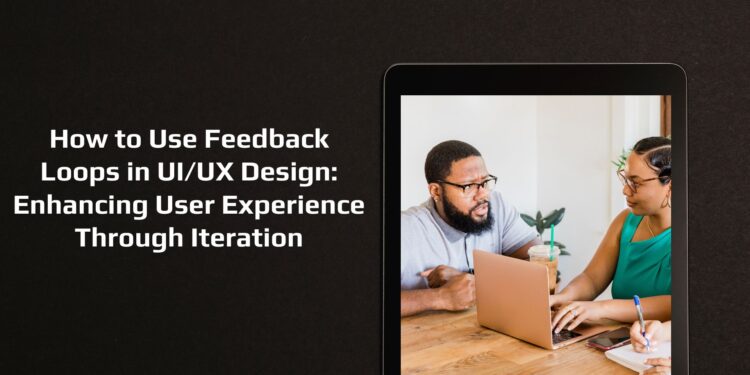In the ever-evolving world of digital products, the importance of user-centric design cannot be overstated. One of the most powerful tools in achieving this is the feedback loop—a continuous cycle of observation, analysis, and improvement. By integrating feedback loops into the UI/UX design process, designers can refine user interactions, solve usability issues, and drive product success. This article explores how feedback loops work, the types commonly used in UI/UX, and practical ways to implement them effectively.
What Is a Feedback Loop in UI/UX Design?
A feedback loop in UI/UX design refers to the process of collecting user input, analyzing behavior, and iteratively improving the product based on that data. It’s a cyclical system where the product evolves in response to real-world usage and insights, creating a dynamic relationship between users and the design team.
There are three main phases in a typical feedback loop:
- Input – Users interact with the design.
- Feedback Collection – Designers gather responses, metrics, or behavioral data.
- Action – Insights are translated into design updates or improvements.
By repeating this cycle, products become more aligned with user needs and expectations over time.
Types of Feedback Loops in UI/UX Design
Internal Feedback Loops
These loops occur within the design and development team. They involve peer reviews, stakeholder input, usability testing sessions, and team retrospectives. While they don’t involve end-users directly, they help refine the product based on professional and strategic insights.
External Feedback Loops
These involve actual users and are crucial for understanding how your design performs in the wild. They include user surveys, A/B testing, heatmaps, support tickets, and user interviews.
Implicit Feedback Loops
This type focuses on behavioral data—how users navigate a product, where they click, how long they stay on a page, etc. Tools like Google Analytics, Hotjar, and Mixpanel help collect this data without needing direct user input.
Explicit Feedback Loops
These rely on user-provided information—such as satisfaction surveys, feature requests, or usability ratings. They are straightforward but require user willingness to participate.
Benefits of Using Feedback Loops in UI/UX
- Improved Usability: Iterative improvements ensure that the product becomes more intuitive over time.
- User Satisfaction: Listening to users fosters trust and loyalty.
- Faster Problem Detection: Bugs and friction points are identified early.
- Product Alignment: Keeps the product aligned with business goals and user expectations.
- Data-Driven Design: Reduces guesswork by basing decisions on actual user behavior.
Implementing Feedback Loops in Your UI/UX Process
Start with User Research
Before launching or redesigning a product, conduct surveys, interviews, and field studies to understand user goals, frustrations, and context. This will form your initial feedback loop baseline.
Prototype and Test Early
Use wireframes or interactive prototypes to gather early feedback. Tools like Figma, InVision, or Adobe XD allow for quick iterations. Conduct usability tests to watch how users interact and where they struggle.
Leverage Analytics Tools
Post-launch, tools like Google Analytics, FullStory, or Hotjar can track user behavior in real-time. Use these insights to identify patterns such as drop-off points or ignored features.
Implement In-App Feedback Options
Allow users to leave comments or report bugs directly within the app. Use features like thumbs up/down, emoji reactions, or short surveys to make feedback easy and unobtrusive.
Use A/B Testing
Compare two versions of a design to determine which performs better. This approach is especially useful for optimizing calls-to-action, onboarding flows, or checkout pages.
Iterate Regularly
Create design sprints or regular update cycles where feedback is analyzed and implemented. Maintain a product backlog to prioritize changes based on user impact.
Close the Loop
Don’t just collect feedback—act on it. Also, let users know when their input results in a change. This encourages more feedback and strengthens trust in the product.
Real-World Example: Feedback Loops in Action
Consider an e-commerce platform noticing a high cart abandonment rate. Using session recordings (implicit feedback), they identify that users are confused by shipping options. They redesign the checkout flow and test it with A/B testing (explicit feedback). The winning design reduces abandonment by 30%. Continuous surveys confirm improved satisfaction, validating the effectiveness of the feedback loop.
Best Practices
- Make Feedback Collection Continuous: Embed tools and mechanisms in your product for ongoing insights.
- Prioritize Actionable Feedback: Not all feedback is equally useful—focus on data that aligns with key metrics.
- Document Changes and Results: Track how each iteration performs and builds on the last.
- Engage Cross-Functional Teams: Involve developers, product managers, and customer support for a holistic view.
- Respect User Privacy: Be transparent about data collection and offer opt-in options.
Conclusion
In a competitive digital landscape, simply designing a beautiful interface is not enough. What truly differentiates a great product is how well it listens to its users and evolves accordingly. Feedback loops are essential to building UI/UX that resonates, performs, and improves over time. By embedding continuous feedback into your design workflow, you not only enhance usability but also foster a stronger relationship with your users—creating products that truly serve their needs.
Whether you’re refining an existing interface or developing a new product from scratch, leveraging feedback loops should be a core part of your UI/UX strategy. Iterate, learn, and grow—because in great design, feedback is fuel.












